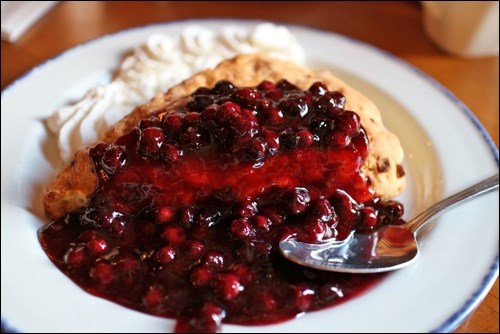Saskatoons can be long-lived, productive and attractive shrubs. But, being a native plant means there several native insects, diseases and animals that can cause problems. Furthermore, since it has a short history of cultivation, we are still learning how to domesticate it.
While adapted to a wide range of soil types, saskatoons do better in deep, well drained, light to medium loam soil with high organic matter levels. Plant in full sun with protection from the wind, spacing them one to 1.3 metres apart. Because they bloom early and the flowers are vulnerable to frost damage, select areas with good air drainage to avoid frost pockets. According to Alberta Agriculture recommendations, fertilize between flowering and harvest, spreading 150 millitres of 23-23-0 or 27-14-0 under the branches out 30 centimetres.
Control weeds, especially perennial weeds, before planting. Immediately after planting apply a 10 centimetre-deep organic mulch layer over the soil surface between plants to control annual weeds, conserve moisture, prevent the splash of soil-borne diseases onto leaves and fruit, and add organic matter and nutrients to the soil over time.
Saskatoons produce berries on the previous year’s and older wood, with vigorous branches less than four years old typically producing the highest quality fruit. Prune in early spring before bud break. First remove diseased, damaged, dead or weak branches as well as those low to the ground. Then prune out a few of the oldest thickest branches, making the cuts as close to the base of the plant (ground level) as possible to open up the centre and encourage new growth.
Maintain even soil moisture during the year of establishment. Once established, and depending on weather conditions, saskatoons require 15-25 millimetres of water per week. Unless the weather is very hot and windy, ease up on the irrigation a few days prior to harvest to avoid diluting the flavour constituents within the fruit.
Diseases such as black leaf, Cytospora dieback and canker, saskatoon-juniper rust and Entomosporium leaf spot occasionally occur. No fungicides are registered for home garden use so cultural methods are your only control options. Prune out infected plant parts, avoid excessive nitrogen fertilizer that causes soft succulent growth, water the soil rather than the foliage and control weeds.
Insect damage varies from year to year. No insecticides are registered for home garden use either so the best tactic is to plant a few different cultivars in separate areas of your yard and hope the insects are easily confused.
Deer, rabbit, mice and birds are also fond of saskatoons. Damage is dependent on population density and the availability of other food. Tree guards (on young plants) and repellents provide some protection from browsing animals. Birds with nestlings to feed can be voracious consumers of ripe fruit. My own philosophy has been to plant enough for all and graciously pay the birds in fruit in exchange for their insect control services.
Saskatoons are usually ready to pick in July. The fruit ripens over a shorter period with even soil moisture allowing harvest in just one or two pickings. They’re ready to pick when they’re blue or dark purple and no longer hard – at which point they will be sweet, juicy and tart. Nearly ripe fruit have a higher vitamin C content with higher acidity and more pectin — factors that favour jelling and enhance flavor. Fully ripe fruit is higher in sugar and better for wine making. Pick early in the morning when the fruit is cool, dry and free of dew. Cool the berries immediately for fresh use. Or freeze them within a few hours for winter delights.
Sara Williams is the author of the newly revised Creating the Prairie Xeriscape and the Saskatoon Forestry Farm Park & Zoo: A Photographic History. Just back from Morocco, Sara will also be hosting a garden tour to Ireland in September, 2015. For more information, call Ruth at 1-888-778-2378.
— This column is provided courtesy of the Saskatchewan Perennial Society (www.saskperennial.ca; hortscene@yahoo.com). Check out our Bulletin Board or Calendar for upcoming garden information sessions.



